What to Do When Your Air Compressor Won’t Turn On

Having an air compressor is essential for many home improvement projects and automotive repairs. However, there may come a time when your air compressor won’t turn on, leaving you frustrated and unable to complete your tasks. Before calling for professional help or rushing to buy a new compressor, there are a few troubleshooting steps you can try to get your machine up and running again.
Firstly, check the power source. Make sure the air compressor is plugged in and that the outlet is working properly. You can try plugging another electronic device into the same outlet to see if it receives power. If the outlet is working fine, move on to the compressor itself.
Next, inspect the power cord for any signs of damage. Look for frayed wires, loose connections, or any burns or discoloration. If you find any issues, it is important to replace the power cord immediately. Faulty wiring can pose a serious safety hazard. Furthermore, check the on/off switch and ensure that it is in the “on” position.
If the power source and the power cord are in good condition, the next step is to examine the pressure switch. The pressure switch is responsible for turning the compressor on and off based on the air pressure in the tank. Sometimes, the pressure switch can become stuck or faulty, preventing the compressor from turning on. Try tapping the pressure switch gently to see if this releases it. If not, you may need to replace the pressure switch.
Another possible cause for the air compressor not turning on is a tripped circuit breaker. Check the circuit breaker box and see if the breaker for the compressor has flipped. If it has, simply reset the breaker and try turning on the air compressor again. If the breaker trips again, there could be a more serious electrical issue that requires professional assistance.
If none of these troubleshooting steps resolve the issue, it may be time to consult a professional. They will have the expertise to diagnose and fix any complex problems with your air compressor. Remember, trying to fix electrical issues without the proper knowledge can be dangerous, so it’s always best to seek professional help when in doubt.
Common Reasons Your Air Compressor Won’t Start
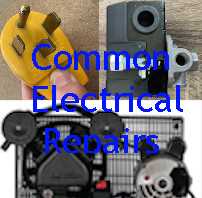
If your air compressor won’t start, there are several common reasons that could be causing the issue. By identifying the underlying problem, you can troubleshoot and resolve the issue more effectively.
1. Power supply issues
One of the most common reasons for an air compressor not starting is a power supply problem. Check if the compressor is properly plugged into a working electrical outlet. Also, ensure that the circuit breaker or fuse is not tripped or blown. If there is no power reaching the compressor, it won’t start.
2. Faulty pressure switch
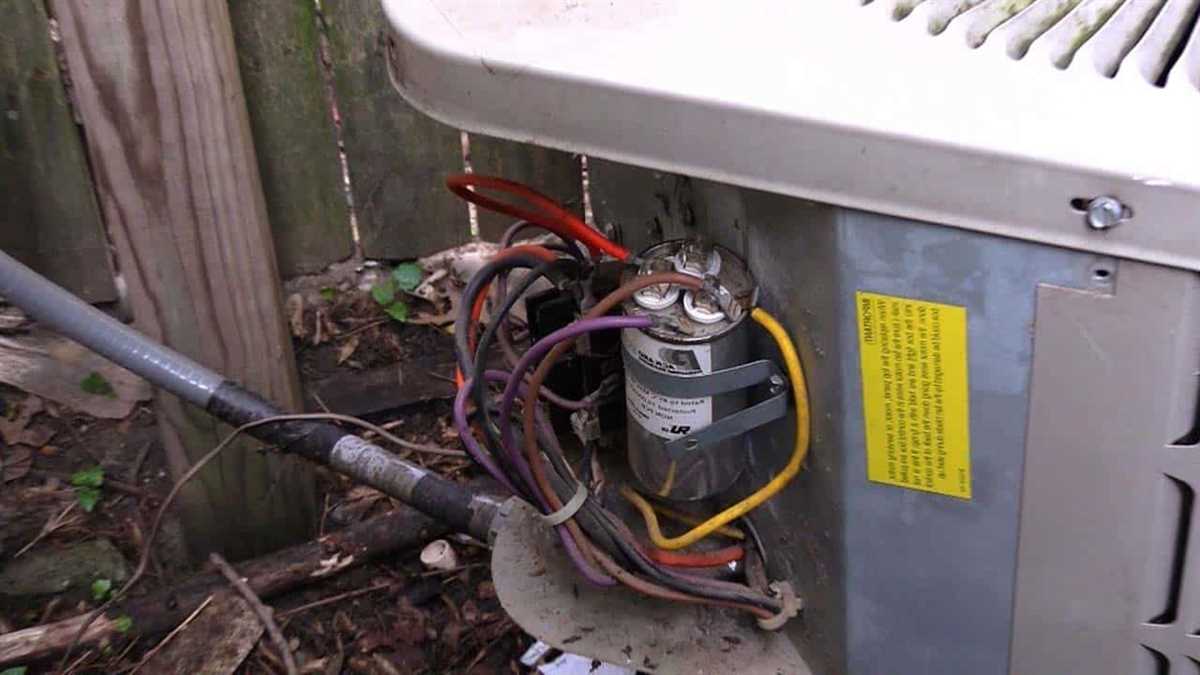
The pressure switch in an air compressor is responsible for turning the compressor on and off based on the pressure levels in the tank. If the pressure switch is faulty or not properly adjusted, it can prevent the compressor from starting. Inspect the pressure switch and ensure it is functioning correctly.
3. Motor issues
A faulty motor can also prevent an air compressor from starting. Check if the motor is receiving power and if all the connections are secure. If the motor is making unusual noises or producing burning smells, it may need to be repaired or replaced.
4. Capacitor problems
The capacitor in an air compressor helps the motor start by providing an extra electrical boost. If the capacitor is faulty or worn out, it can prevent the compressor from starting. Test the capacitor’s functionality using a multimeter and replace it if necessary.
5. Belt or pulley issues
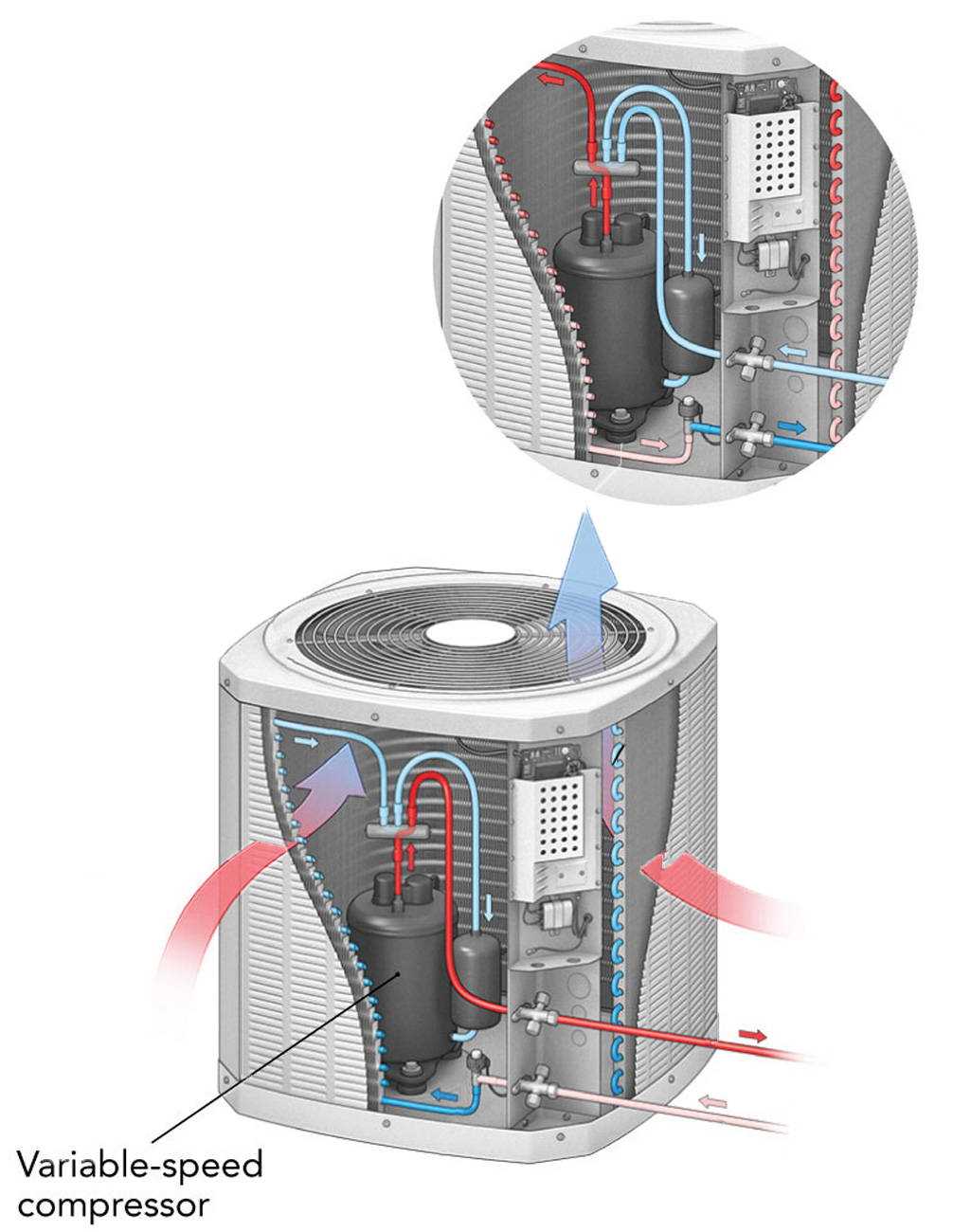
If you have a belt-driven air compressor, a loose or broken belt can prevent the compressor from starting. Inspect the belt for signs of wear, damage, or misalignment. Similarly, check if the pulleys are properly aligned and tightened. Replace any damaged belts or adjust the pulleys accordingly.
By investigating these common reasons for an air compressor not starting, you can diagnose the problem and take appropriate steps to get your compressor up and running again.
Power Supply Issues
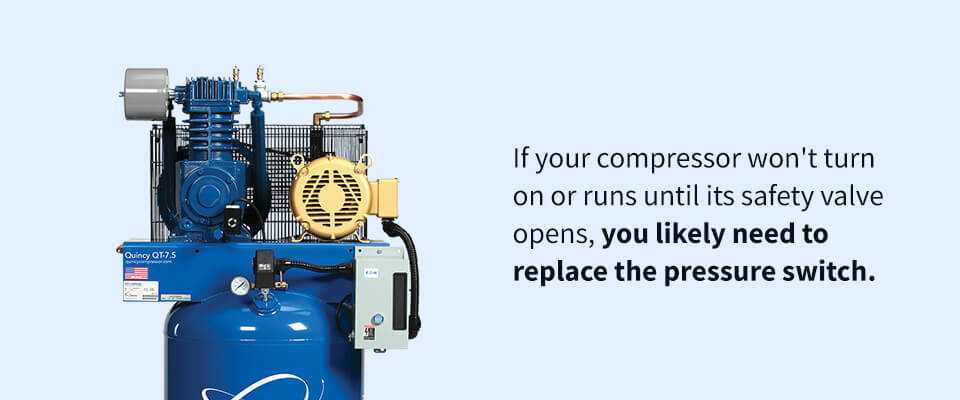
If your air compressor won’t turn on, one of the potential issues could be related to the power supply. There are several aspects to consider when troubleshooting power supply issues:
1. Check the power cord
Inspect the power cord connected to the air compressor. Look for any noticeable damage such as cuts, frays, or exposed wires. Make sure the cord is properly plugged into a working electrical outlet.
2. Test the outlet
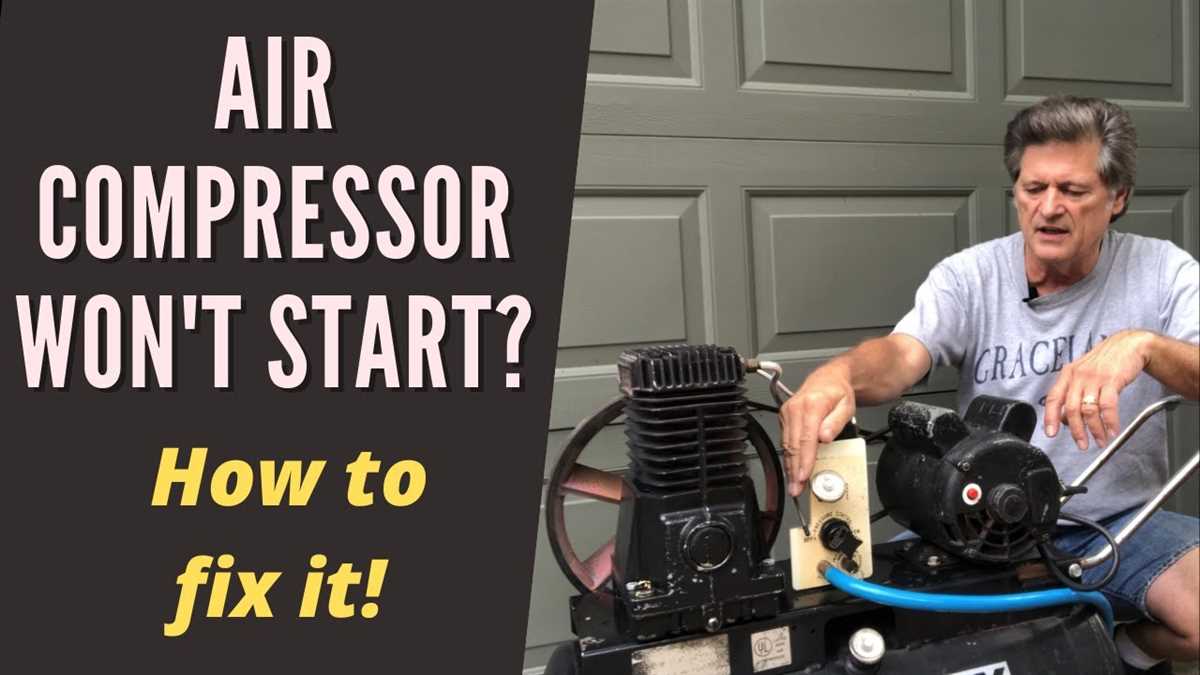
Verify that the electrical outlet is receiving power. Try plugging in another device or using a voltage tester to check for any issues. If the outlet is not functioning, it may be necessary to reset a tripped circuit breaker or replace a blown fuse.
3. Consider the extension cord
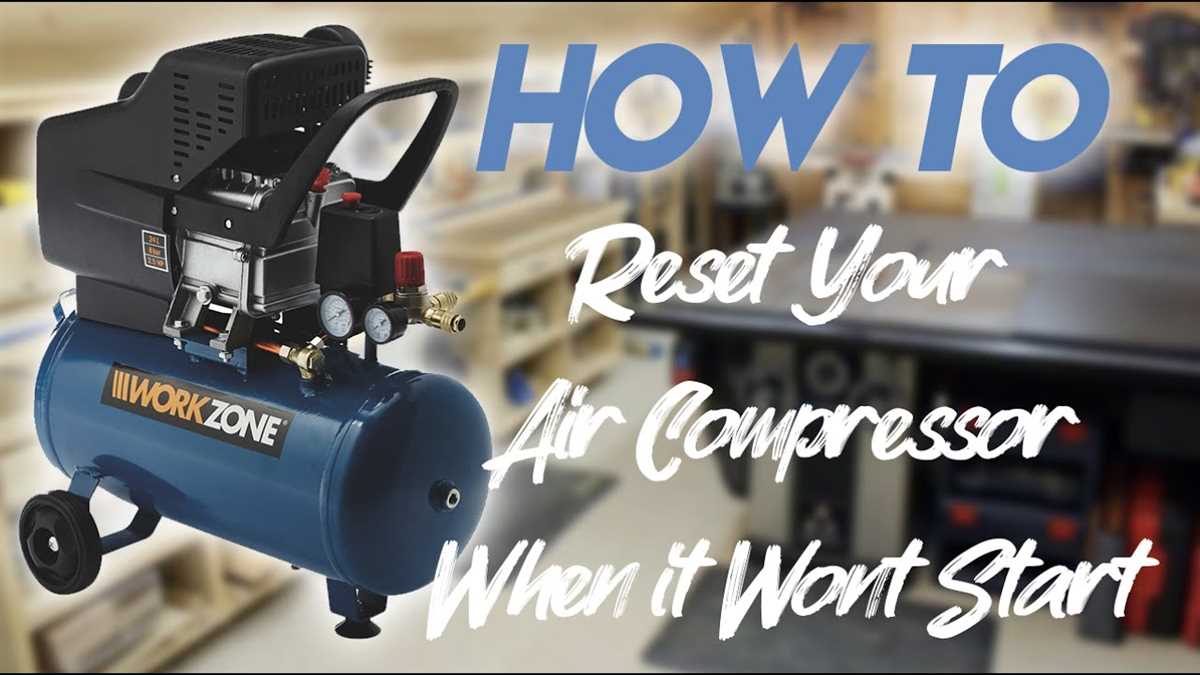
If you are using an extension cord, ensure it is the proper gauge and length for the power requirements of your air compressor. Using an inadequate or overly long extension cord can lead to power loss or voltage drop, preventing the compressor from turning on.
4. Check the on/off switch
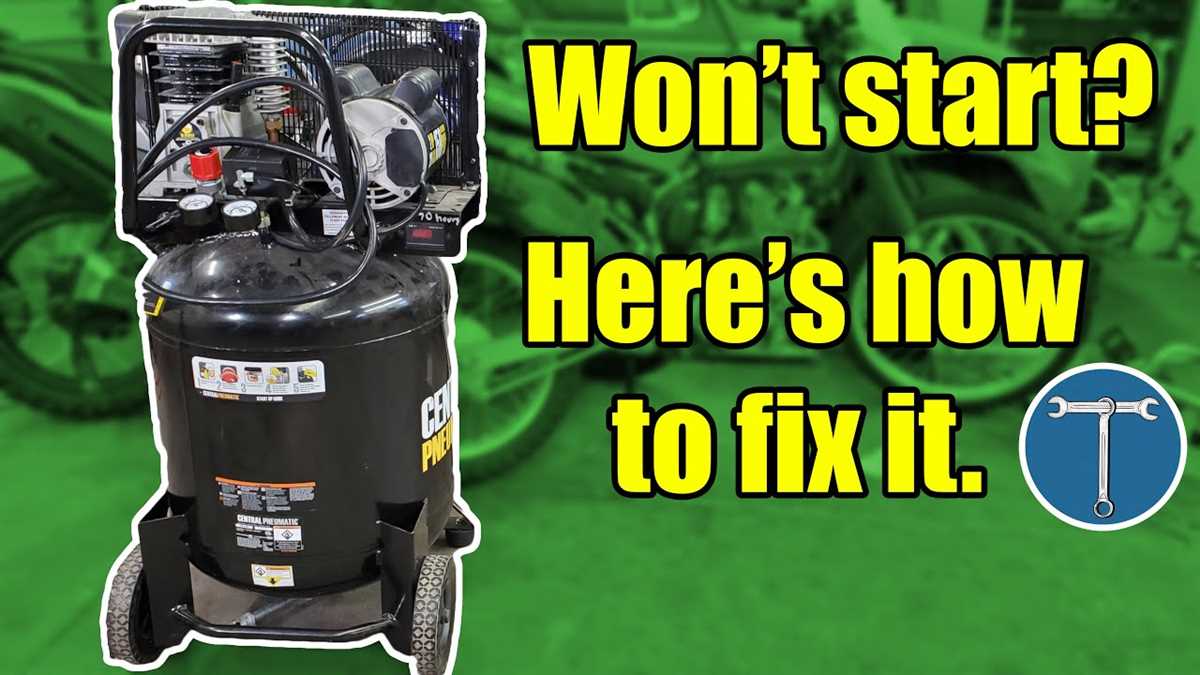
Inspect the on/off switch on the air compressor. Make sure it is in the “on” position and functioning properly. If the switch appears to be faulty, it may need to be replaced.
If you have checked all of these power supply aspects and your air compressor still won’t turn on, it may be necessary to contact a professional for further assistance.
Faulty Pressure Switch
A faulty pressure switch can be the reason your air compressor won’t turn on. The pressure switch is responsible for monitoring the air pressure in the tank and turning the compressor on and off accordingly. If the pressure switch is not functioning properly, it may not detect the correct air pressure and fail to engage the compressor.
There are several signs that can indicate a faulty pressure switch. One common sign is when the compressor doesn’t turn on at all, even when the tank is empty. Another sign is when the compressor fails to shut off when the tank reaches its maximum pressure. Additionally, if you notice that the pressure gauge is not displaying accurate readings, it could be a sign of a faulty pressure switch.
If you suspect that the pressure switch is the issue, you can try adjusting the pressure settings. Consult the user manual or manufacturer’s instructions for guidance on how to adjust the pressure switch. If adjusting the settings doesn’t solve the problem, it may be necessary to replace the pressure switch entirely.
Replacing a pressure switch generally involves disconnecting the power supply, draining the tank, and removing the old switch. It’s important to follow the manufacturer’s instructions and take necessary safety precautions when replacing the switch. Once the new pressure switch is installed, test the compressor to ensure it turns on and off correctly.
Motor Problems
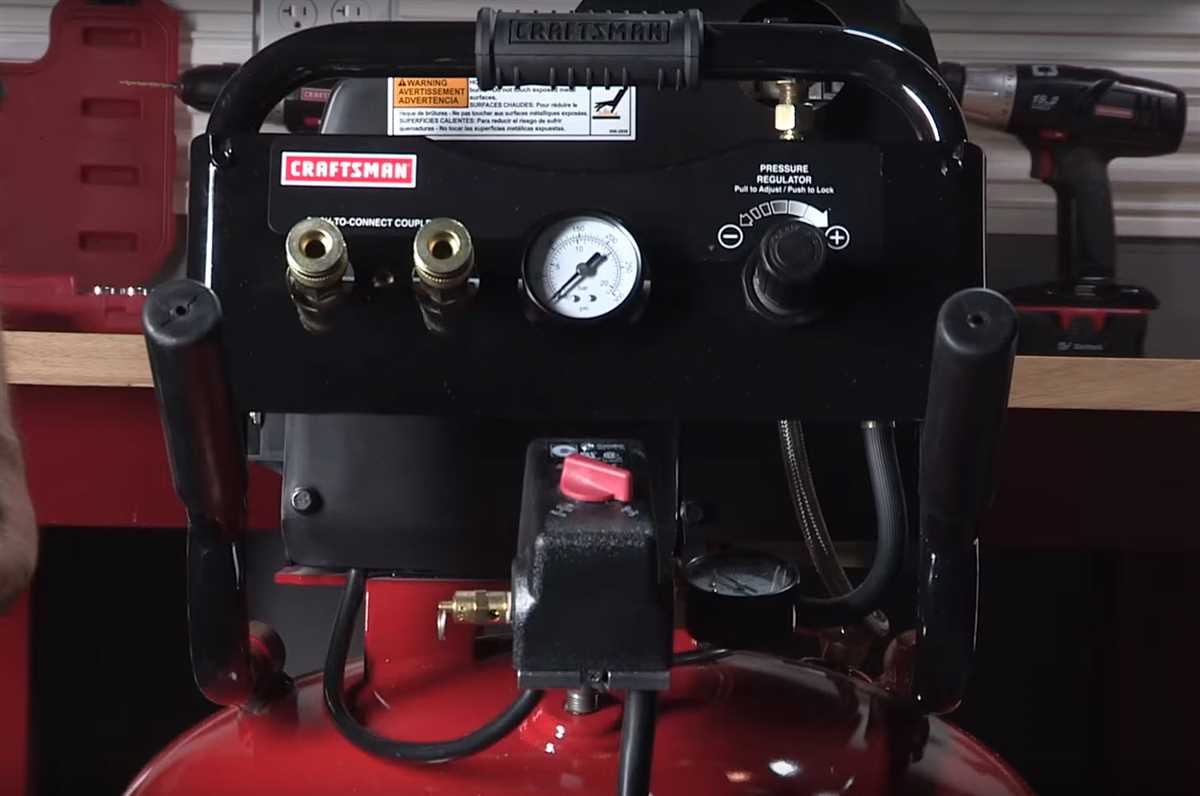
If your air compressor won’t turn on, one possible issue could be motor problems. The motor is an essential component of the air compressor and if it is not functioning properly, the compressor will not start. There are several motor-related problems that may prevent the air compressor from turning on.
Power Supply
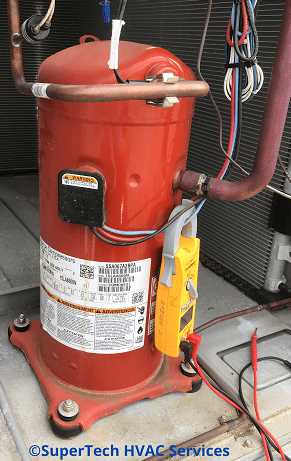
One common motor problem is an issue with the power supply. Check if the air compressor is properly plugged into a functioning power outlet. Make sure the power cord is not damaged and the circuit breaker is not tripped. If there is a problem with the power supply, the motor will not receive proper electricity to start the compressor.
Motor Capacitor
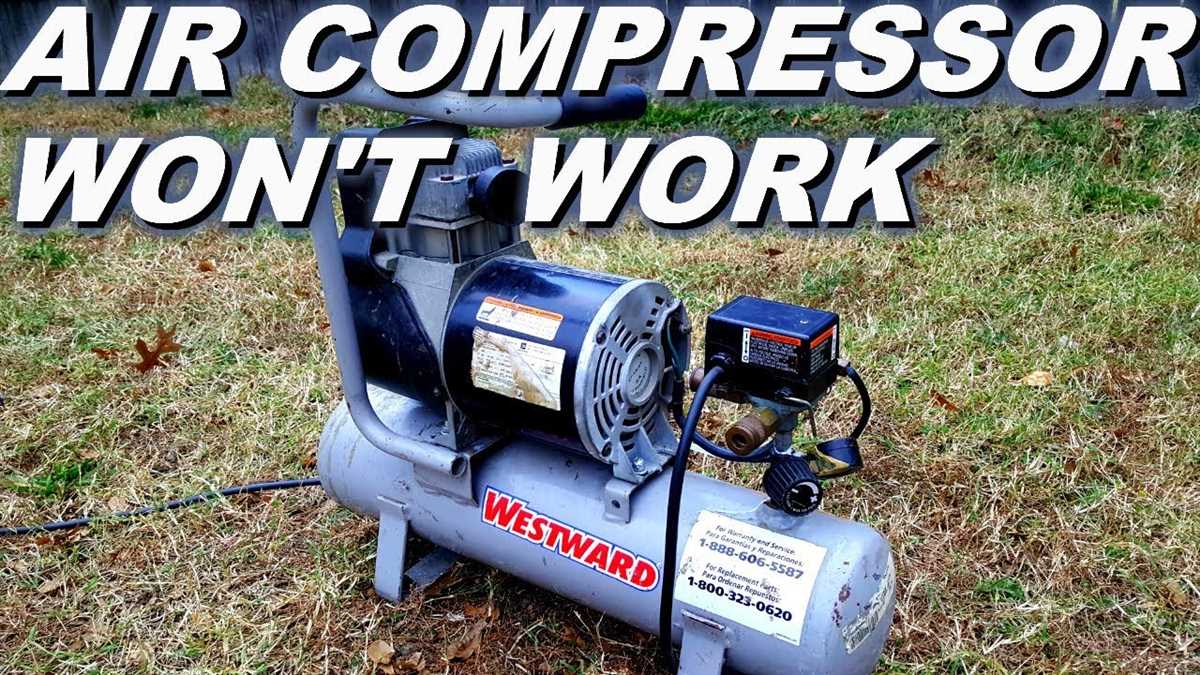
Another motor-related problem is a faulty capacitor. The capacitor is responsible for providing a boost of electrical current to start the motor. If the capacitor is defective or worn out, it may prevent the motor from starting. Inspect the capacitor for any signs of damage or bulging. If necessary, replace the capacitor to resolve the issue.
Motor Overload
A motor overload can also cause the air compressor to not turn on. This occurs when the motor becomes overheated due to excessive power or a mechanical problem. If the motor overload protection switch is tripped, it will shut off power to the motor. Allow the motor to cool down and then reset the overload switch to see if that resolves the issue.
Motor Winding
The motor winding plays a crucial role in the motor’s function. If the winding is damaged or faulty, the motor may not start. Inspect the motor winding for any signs of burns or loose connections. If you identify any issues, it may be necessary to replace the motor winding to get the air compressor running again.
In conclusion, motor problems can be a common cause of an air compressor not turning on. Issues with the power supply, motor capacitor, motor overload, or motor winding can prevent the motor from functioning properly. Carefully inspect and troubleshoot these components to identify and fix any motor-related problems.
Malfunctioning Start Capacitor
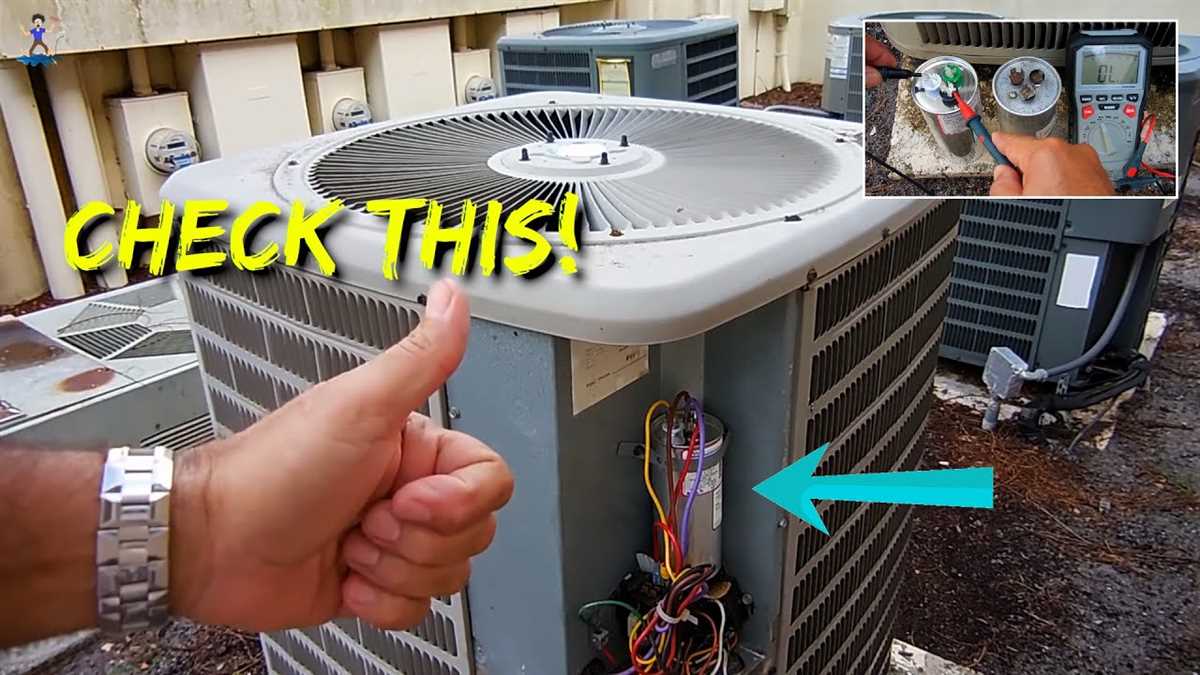
The start capacitor is responsible for providing an extra jolt of power to get your air compressor motor running. If the start capacitor is malfunctioning, it can prevent the compressor from turning on at all.
Symptoms:
- The compressor makes a humming noise but does not start.
- The compressor trips the circuit breaker or blows a fuse when you try to turn it on.
Possible Solutions:
- Check for visible damage: Inspect the start capacitor for any signs of damage such as bulging, leaking, or burning. If you see any damage, the capacitor will need to be replaced.
- Test the capacitor: Use a multimeter to test the capacitance of the start capacitor. If the reading is significantly lower than the manufacturer’s specifications, the capacitor is likely faulty and should be replaced.
- Replace the capacitor: If you have determined that the start capacitor is malfunctioning, you will need to replace it. Consult the air compressor’s manual or contact the manufacturer for the correct replacement part.
If you are not comfortable working with electrical components or if you are unsure about the diagnosis, it is recommended to seek the assistance of a professional technician.
Clogged Air Filter
One common reason for an air compressor not turning on is a clogged air filter. The air filter is an essential component of the compressor as it helps to keep dirt, debris, and other particles from entering the system and causing damage. However, over time, the air filter can become clogged with dirt and dust. This can restrict the airflow and lead to the compressor not being able to turn on properly.
Symptoms
If the air filter is clogged, you may notice certain symptoms. Firstly, the compressor may struggle to start or turn on, or you may hear a clicking sound when you try to turn it on. Additionally, you may notice reduced airflow or weak output when using the compressor. These symptoms indicate that the air filter needs to be cleaned or replaced.
Solution
To address a clogged air filter, you will need to clean or replace it. Start by locating the air filter, which is typically located near the intake valve. Remove the filter and check for accumulation of dirt and debris. If the filter appears dirty, you can clean it by gently tapping it to remove loose particles or by washing it with water and mild detergent. Allow the filter to fully dry before reinstalling it. If the filter is heavily clogged or damaged, it’s recommended to replace it with a new one.
Tips for prevention
To prevent the air filter from getting clogged in the future, it’s important to perform regular maintenance. This includes checking and cleaning the filter periodically, especially if you are operating the compressor in dusty or dirty environments. You can also consider using a pre-filter or an additional filtration system to provide extra protection for the air compressor. By ensuring the air filter is clean and free from obstruction, you can help maintain the efficiency and longevity of your air compressor.
Issues with the Pressure Relief Valve
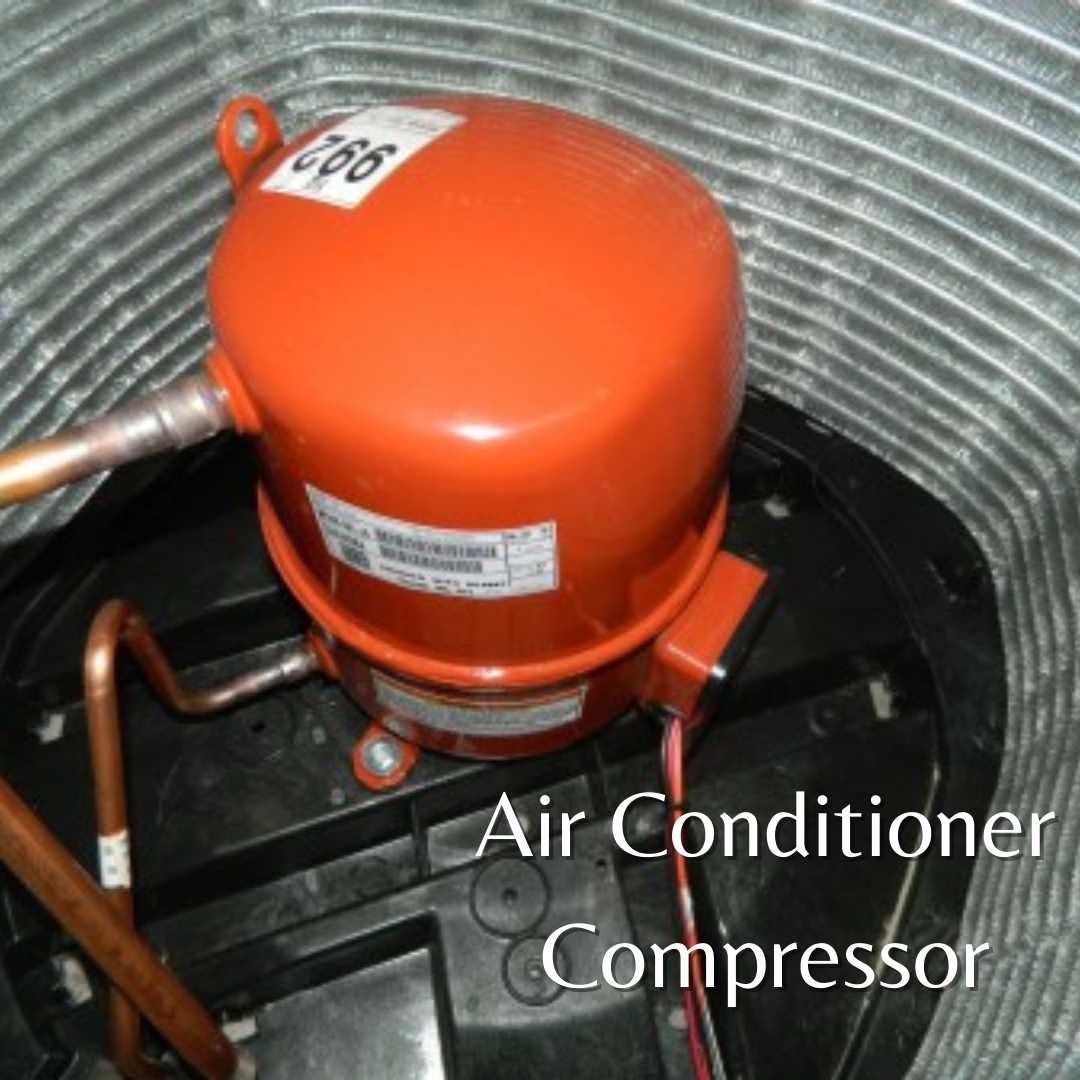
One common issue that can prevent an air compressor from turning on is a problem with the pressure relief valve. The pressure relief valve is a safety feature that releases excess pressure from the tank to prevent damage or explosions. However, if the valve is faulty or damaged, it may not be allowing the compressor to build up enough pressure to turn on.
If you suspect that the pressure relief valve is the issue, there are a few troubleshooting steps you can take. First, check to see if the valve is stuck in the open position. This can often happen if the valve becomes corroded or dirty. Try gently tapping on the valve or cleaning it with compressed air to see if it will close properly.
Another issue that can occur with the pressure relief valve is a buildup of debris or sediment. Over time, dust, dirt, and other particles can accumulate inside the valve, causing it to become clogged and not function properly. In this case, you may need to remove the valve and clean it thoroughly to ensure that it is able to close and open correctly.
In some cases, the pressure relief valve may need to be replaced entirely. If the valve is damaged or worn out, it may not be able to effectively release pressure or close off the tank when necessary. Look for signs of wear or damage, such as cracks or leaks, and if necessary, purchase a new valve and install it according to the manufacturer’s instructions.
Remember, working on an air compressor can be dangerous, so if you are not comfortable troubleshooting or repairing the pressure relief valve yourself, it is always best to consult a professional technician who can safely diagnose and fix the issue for you.
Broken Electric Connections
If your air compressor won’t turn on, one possible cause could be broken electric connections. There are several electrical components that can become damaged or disconnected, preventing power from reaching the compressor.
Power Cord: Check the power cord for any visible signs of damage, such as frayed or exposed wires. If the power cord is damaged, it will need to be replaced.
Outlet: Make sure that the outlet you are using to power the air compressor is functioning properly. Test the outlet with another device to see if it is providing power. If the outlet is not working, try using a different one or resetting the circuit breaker.
Switch: The power switch on the air compressor may be faulty or worn out, preventing it from turning on. Check the switch for any signs of damage or wear. If necessary, replace the switch.
Fuse or Circuit Breaker: If the air compressor is equipped with a fuse or circuit breaker, check to see if it has tripped. If the fuse is blown or the circuit breaker has tripped, replace the fuse or reset the circuit breaker.
Internal Wiring: If all the external electrical connections are in good condition, the issue may lie with the internal wiring of the air compressor. In this case, it is recommended to consult a professional technician who can diagnose and repair the problem.
Overheating Protection System Activation
When your air compressor won’t turn on, it is possible that the overheating protection system has been activated. This system is designed to prevent damage to the compressor motor when it becomes too hot.
Causes of Overheating:
- Insufficient cooling: If the compressor is not getting enough airflow, such as when the air intake vents are blocked or the cooling fan is not functioning properly, it can lead to overheating.
- Low oil level: Insufficient lubrication can cause increased friction in the compressor motor, leading to overheating.
- Continuous operation: If the compressor has been running for an extended period without any breaks, it can overheat.
Indications of Overheating:
- The compressor may shut off suddenly.
- You may notice a burning smell coming from the compressor.
- The motor may feel excessively hot to the touch.
Steps to Resolve Overheating:
1. Allow the compressor to cool down: If the overheating protection system is activated, give the compressor some time to cool down. Turn off the compressor and let it rest for at least 30 minutes before attempting to restart.
2. Check for airflow obstruction: Inspect the air intake vents and ensure they are clear of any debris or obstructions. Additionally, make sure the cooling fan is functioning properly.
3. Check the oil level: If the compressor uses oil, check the oil level and add more if necessary. Refer to the manufacturer’s instructions for the correct type and amount of oil to use.
4. Reduce the workload: If the compressor has been operating continuously, reduce the workload or take breaks between heavy tasks to allow the motor to cool down.
If these steps do not resolve the issue, it is recommended to contact a professional technician to inspect and repair your air compressor.
FAQ:
Why won’t my air compressor turn on?
There can be several reasons why your air compressor won’t turn on. Some common causes include a tripped circuit breaker, a faulty pressure switch, a blown fuse, a malfunctioning motor, or a problem with the power supply.
How can I check if the circuit breaker is tripped?
To check if the circuit breaker is tripped, you can visually inspect it to see if the switch is in the “off” position. If it is, you can try flipping the switch back to the “on” position. If the breaker keeps tripping, you may want to call an electrician to inspect the wiring.
What should I do if the pressure switch is faulty?
If you suspect that the pressure switch is faulty, you can try resetting it by turning off the air compressor, unplugging it from the power source, and draining the air from the tank. Then, remove the cover of the pressure switch and press the small reset button inside. If this doesn’t solve the issue, you may need to replace the pressure switch.
What can I do if the motor is not working?
If the motor of your air compressor is not working, you can first check if the power supply is functioning properly by plugging another device into the same outlet. If the power supply is fine, you may need to inspect and replace the motor capacitor or contact a professional for further troubleshooting and repair.
Video:













